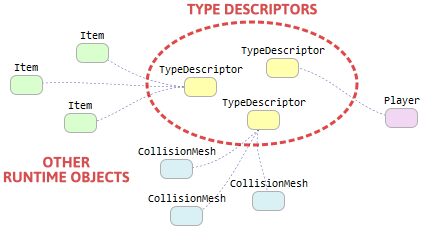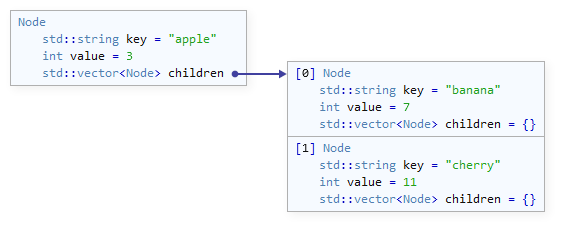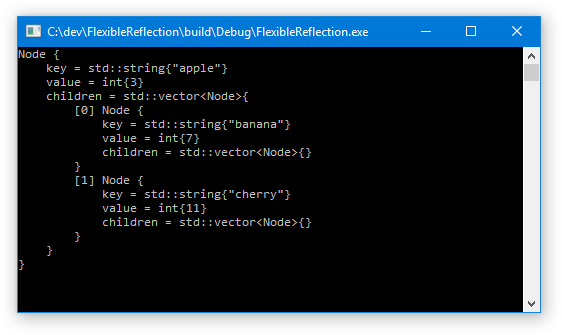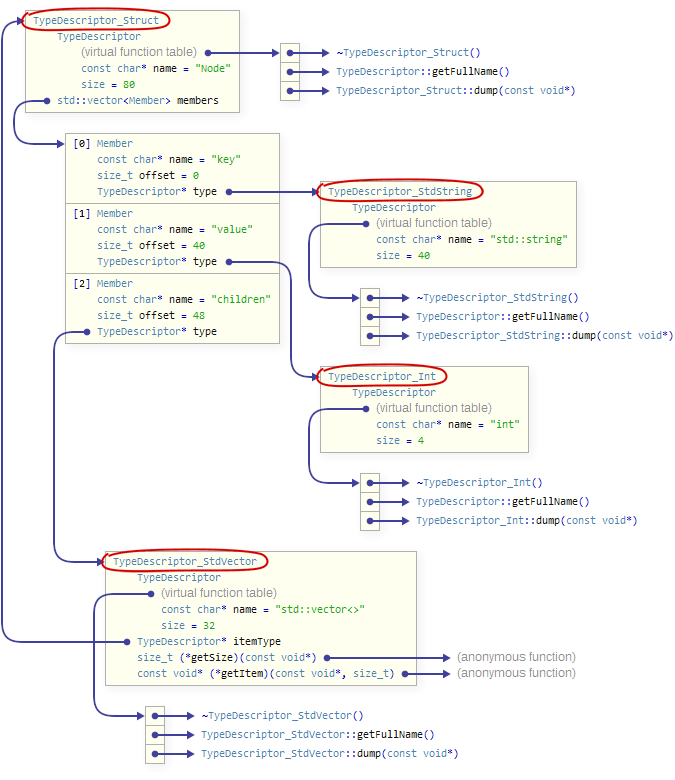

A Flexible Reflection System in C++: Part 1
source link: https://preshing.com/20180116/a-primitive-reflection-system-in-cpp-part-1/
Go to the source link to view the article. You can view the picture content, updated content and better typesetting reading experience. If the link is broken, please click the button below to view the snapshot at that time.

Jan 16, 2018
A Flexible Reflection System in C++: Part 1
In this post, I’ll present a small, flexible system for runtime reflection using C++11 language features. This is a system to generate metadata for C++ types. The metadata takes the form of TypeDescriptor objects, created at runtime, that describe the structure of other runtime objects.

I’ll call these objects type descriptors. My initial motivation for writing a reflection system was to support serialization in my custom C++ game engine, since I have very specific needs. Once that worked, I began to use runtime reflection for other engine features, too:
- 3D rendering: Every time the game engine draws something using OpenGL ES, it uses reflection to pass uniform parameters and describe vertex formats to the API. It makes graphics programming much more productive!
- Importing JSON: The engine’s asset pipeline has a generic routine to synthesize a C++ object from a JSON file and a type descriptor. It’s used to import 3D models, level definitions and other assets.
This reflection system is based on preprocessor macros and templates. C++, at least in its current form, was not designed to make runtime reflection easy. As anyone who’s written one knows, it’s tough to design a reflection system that’s easy to use, easily extended, and that actually works. I was burned many times by obscure language rules, order-of-initialization bugs and corner cases before settling on the system I have today.
To illustrate how it works, I’ve published a sample project on GitHub:
This sample doesn’t actually use my game engine’s reflection system. It uses a tiny reflection system of its own, but the most interesting part – the way type descriptors are created, structured and found – is almost identical. That’s the part I’ll focus on in this post. In the next post, I’ll discuss how the system can be extended.
This post is meant for programmers who are interested in how to develop a runtime reflection system, not just use one. It touches on many advanced features of C++, but the sample project is only 242 lines of code, so hopefully, with some persistence, any determined C++ programmer can follow along. If you’re more interested in using an existing solution, take a look at RTTR.
Demonstration
In Main.cpp, the sample project defines a struct named Node. The REFLECT() macro tells the system to enable reflection for this type.
struct Node {
std::string key;
int value;
std::vector<Node> children;
REFLECT() // Enable reflection for this type
};
At runtime, the sample creates an object of type Node.
// Create an object of type Node
Node node = {"apple", 3, {{"banana", 7, {}}, {"cherry", 11, {}}}};
In memory, the Node object looks something like this:

Next, the sample finds Node’s type descriptor. For this to work, the following macros must be placed in a .cpp file somewhere. I put them in Main.cpp, but they could be placed in any file from which the definition of Node is visible.
// Define Node's type descriptor REFLECT_STRUCT_BEGIN(Node) REFLECT_STRUCT_MEMBER(key) REFLECT_STRUCT_MEMBER(value) REFLECT_STRUCT_MEMBER(children) REFLECT_STRUCT_END()
Node’s member variables are now said to be reflected.
A pointer to Node’s type descriptor is obtained by calling reflect::TypeResolver<Node>::get():
// Find Node's type descriptor reflect::TypeDescriptor* typeDesc = reflect::TypeResolver<Node>::get();
Having found the type descriptor, the sample uses it to dump a description of the Node object to the console.
// Dump a description of the Node object to the console typeDesc->dump(&node);
This produces the following output:

How the Macros Are Implemented
When you add the REFLECT() macro to a struct or a class, it declares two additional static members: Reflection, the struct’s type descriptor, and initReflection, a function to initialize it. Effectively, when the macro is expanded, the complete Node struct looks like this:
struct Node {
std::string key;
int value;
std::vector<Node> children;
// Declare the struct's type descriptor:
static reflect::TypeDescriptor_Struct Reflection;
// Declare a function to initialize it:
static void initReflection(reflect::TypeDescriptor_Struct*);
};
Similarly, the block of REFLECT_STRUCT_*() macros in Main.cpp look like this when expanded:
// Definition of the struct's type descriptor:
reflect::TypeDescriptor_Struct Node::Reflection{Node::initReflection};
// Definition of the function that initializes it:
void Node::initReflection(reflect::TypeDescriptor_Struct* typeDesc) {
using T = Node;
typeDesc->name = "Node";
typeDesc->size = sizeof(T);
typeDesc->members = {
{"key", offsetof(T, key), reflect::TypeResolver<decltype(T::key)>::get()},
{"value", offsetof(T, value), reflect::TypeResolver<decltype(T::value)>::get()},
{"children", offsetof(T, children), reflect::TypeResolver<decltype(T::children)>::get()},
};
}
Now, because Node::Reflection is a static member variable, its constructor, which accepts a pointer to initReflection(), is automatically called at program startup. You might be wondering: Why pass a function pointer to the constructor? Why not pass an initializer list instead? The answer is because the body of the function gives us a place to declare a C++11 type alias: using T = Node. Without the type alias, we’d have to pass the identifier Node as an extra argument to every REFLECT_STRUCT_MEMBER() macro. The macros wouldn’t be as easy to use.
As you can see, inside the function, there are three additional calls to reflect::TypeResolver<>::get(). Each one finds the type descriptor for a reflected member of Node. These calls use C++11’s decltype specifier to automatically pass the correct type to the TypeResolver template.
Finding TypeDescriptors
(Note that everything in this section is defined in the reflect namespace.)
TypeResolver is a class template. When you call TypeResolver<T>::get() for a particular type T, the compiler instantiates a function that returns the corresponding TypeDescriptor for T. It works for reflected structs as well as for every reflected member of those structs. By default, this happens through the primary template, highlighted below.
By default, if T is a struct (or a class) that contains the REFLECT() macro, like Node, get() will return a pointer to that struct’s Reflection member – which is what we want. For every other type T, get() instead calls getPrimitiveDescriptor<T> – a function template that handles primitive types such as int or std::string.
// Declare the function template that handles primitive types such as int, std::string, etc.:
template <typename T>
TypeDescriptor* getPrimitiveDescriptor();
// A helper class to find TypeDescriptors in different ways:
struct DefaultResolver {
...
// This version is called if T has a static member variable named "Reflection":
template <typename T, /* SFINAE stuff here */>
static TypeDescriptor* get() {
return &T::Reflection;
}
// This version is called otherwise:
template <typename T, /* SFINAE stuff here */>
static TypeDescriptor* get() {
return getPrimitiveDescriptor<T>();
}
};
// This is the primary class template for finding all TypeDescriptors:
template <typename T>
struct TypeResolver {
static TypeDescriptor* get() {
return DefaultResolver::get<T>();
}
};
This bit of compile-time logic – generating different code depending on whether a static member variable is present in T – is achieved using SFINAE. I omitted the SFINAE code from the above snippet because, quite frankly, it’s ugly. You can check the actual implementation in the source code. Part of it could be rewritten more elegantly using if constexpr, but I’m targeting C++11. Even then, the part that detects whether T has a specific member variable will remain ugly, at least until C++ adopts static reflection. In the meantime, however – it works!
The Structure of TypeDescriptors
In the sample project, every TypeDescriptor has a name, a size, and a couple of virtual functions:
struct TypeDescriptor {
const char* name;
size_t size;
TypeDescriptor(const char* name, size_t size) : name{name}, size{size} {}
virtual ~TypeDescriptor() {}
virtual std::string getFullName() const { return name; }
virtual void dump(const void* obj, int indentLevel = 0) const = 0;
};
The sample project never creates TypeDescriptor objects directly. Instead, the system creates objects of types derived from TypeDescriptor. That way, every type descriptor can hold extra information depending on, well, the kind of type descriptor it is.
For example, the actual type of the object returned by TypeResolver<Node>::get() is TypeDescriptor_Struct. It has one additional member variable, members, that holds information about every reflected member of Node. For each reflected member, there’s a pointer to another TypeDescriptor. Here’s what the whole thing looks like in memory. I’ve circled the various TypeDescriptor subclasses in red:

At runtime, you can get the full name of any type by calling getFullName() on its type descriptor. Most subclasses simply use the base class implementation of getFullName(), which returns TypeDescriptor::name. The only exception, in this example, is TypeDescriptor_StdVector, a subclass that describes std::vector<> specializations. In order to return a full type name, such as "std::vector<Node>", it keeps a pointer to the type descriptor of its item type. You can see this in the above memory diagram: There’s a TypeDescriptor_StdVector object whose itemType member points all the way back to the type descriptor for Node.
Of course, type descriptors only describe types. For a complete description of a runtime object, we need both a type descriptor and a pointer to the object itself.
Note that TypeDescriptor::dump() accepts a pointer to the object as const void*. That’s because the abstract TypeDescriptor interface is meant to deal with any type of object. The subclassed implementation knows what type to expect. For example, here’s the implementation of TypeDescriptor_StdString::dump(). It casts the const void* to const std::string*.
virtual void dump(const void* obj, int /*unused*/) const override {
std::cout << "std::string{\"" << *(const std::string*) obj << "\"}";
}
You might wonder whether it’s safe to cast void pointers in this way. Clearly, if an invalid pointer is passed in, the program is likely to crash. That’s why, in my game engine, objects represented by void pointers always travel around with their type descriptors in pairs. By representing objects this way, it’s possible to write many kinds of generic algorithms.
In the sample project, dumping objects to the console is the only functionality implemented, but you can imagine how type descriptors could serve as a framework for serializing to a binary format instead.
In the next post, I’ll explain how to add built-in types to the reflection system, and what the “anonymous functions” are for in the above diagram. I’ll also discuss other ways to extend the system.
Recommend
About Joyk
Aggregate valuable and interesting links.
Joyk means Joy of geeK